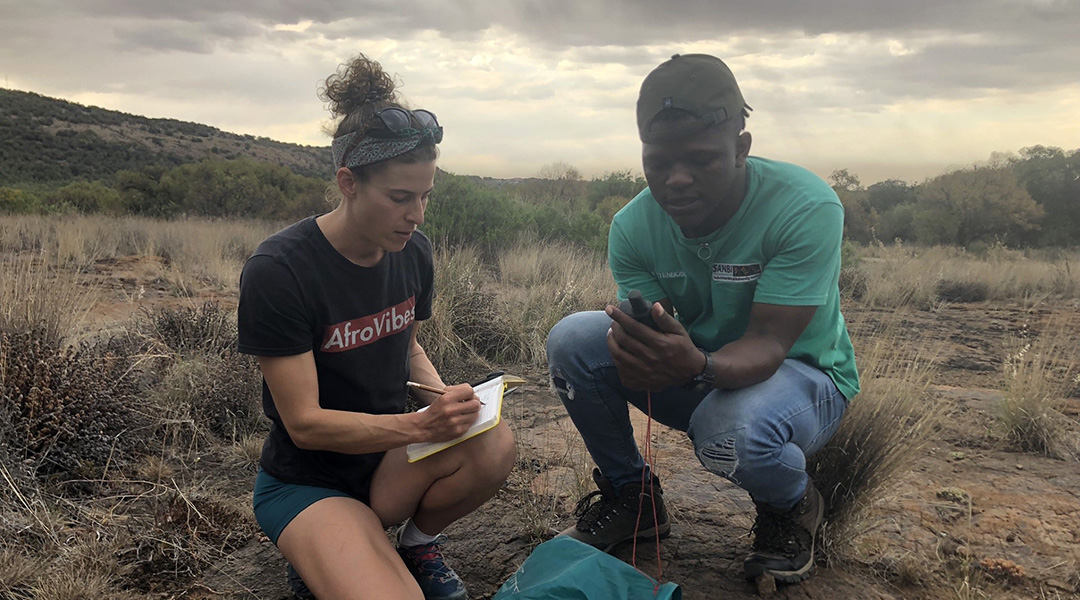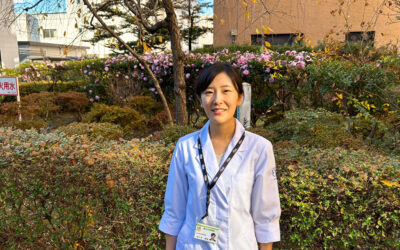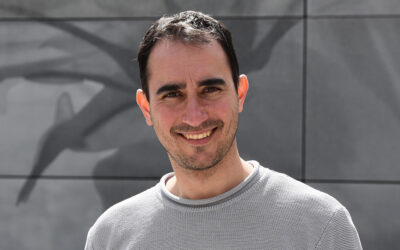Understanding how plants cope with stress is important in the face of global change and could help us engineer more resilient crops. Rose Marks, a botanist who studies how plants adapt to extreme environments, is particularly concerned with drought and how plants can survive without water.
For the past few years, she’s been studying plants known as “resurrection” plants in South Africa, primarily in the provinces of Limpopo and Mpumalanga. Typically found growing in dry, rugged landscapes around the world, these plants have the unique ability to completely dry out, or desiccate, surviving in a hibernation-like state for months at a time without water.
By studying the mechanisms behind their resilience, Marks hopes her research will help scientists understand survival in extreme and changing conditions, and even facilitate engineering desiccation-tolerant food crops.
In this interview, Marks, who will start an assistant professor position at the University of Illinois, shared how she went from exploring the backyard of her small town in New Hampshire to scaling vertical cliff faces deep in the South African bush where she’s been collecting data for the past few years, splitting her time as a post-doc between Michigan State University and the University of Cape Town.
What motivated you to study botany?
I grew up helping my father in the family garden and working on small scale vegetable farms in New Hampshire, and I developed an interest in plants, their many adaptations, and interactions with the environment through this work. I did a semester abroad my sophomore year, in Kenya, studying wildlife and rangeland ecology. I was so inspired by the landscape, but also struck by the magnitude of the drought that was going on there. That experience really did foreshadow what I’m doing now.
What is the resurrection plant, and why is it so special?
Resurrection plants are very diverse. Some resurrection plant are grasses, some are herbaceous flowering plants, some are ferns, and some are bryophytes. There are at least 300 species of plants that are desiccation tolerant, and they have earned the poetic name of “resurrection plants” because they seem to resurrect from the dead. But they’re not actually dead, and while it’s scientifically inaccurate to call them resurrection plants, I will probably never stop using that term.
All of these plants have the ability to survive if their leaves get completely [desiccated]. They can be dry like a potato chip. They go into a state of hibernation, what we call “quiescence”, where metabolic activity and photosynthesis stop, and [the plants] can stay dry for a long time. It depends on the species, but some of the grasses we’re studying, and some of the mosses, can stay dry for years. They can be completely desiccated in the blazing sun and the heat, but they are still alive, and when they get wet again, they spring right back to life. This trait of desiccation tolerance — some people use the term “anhydrobiosis”, which means “life without water” — is actually found across life forms.
There are many bacteria and fungi where the spores — or even sometimes the whole organism — is desiccation tolerant. There are some micro-animals like Tardigrades, or water bears, that are also desiccation tolerant. In plants there are many other tissue types, like seeds, spores, and pollen, that are desiccation tolerant. But resurrection plants are the only plants that have this ability in their photosynthetic or vegetative tissues.
Where do you find resurrection plants?
They can be found on every single continent. We mostly find them on rocky outcroppings, and other very exposed places with minimal soil where not much else can grow. You can also find resurrection plants growing as epiphytes in forest canopies, growing on top of other plants. This is another habitat where water is generally not available, or not available consistently, only coming in short bursts. These plants rehydrate really quickly, take advantage of water when it is available, and then go back into their desiccated state.
Are you studying a particular species?
I started out studying one specific plant, but I’ve now branched out. I’m studying over a dozen different diverse species across different lineages of plants. But the species that brought me to South Africa is Myrothamnus flabellifolia, a very special and beautiful plant that is dear to my heart. It’s one of the most iconic resurrection plants in Southern Africa.
Locally it’s known as Uvukakwabafile in isiZulu, Patje-ya-tshwene in Setswana/Sesotho, Umazifisi in isiNdebele, Mufandichumuka in Shona, or “resurrection bush” in English, and it’s really dramatic when it rehydrates. It’s only found in Southern Africa and it has very special medicinal properties in addition to being desiccation tolerant. It is very aromatic and produces secondary compounds — antioxidants and phenolics — that have a lot of traditional as well as emerging medicinal uses.
Local people have been using it traditionally for centuries. There’s now a growing commercial interest in using extracts of this plant for cosmetics. A lot of populations of this plant are threatened by overharvest. But luckily, in South Africa, it’s protected.
What is the goal of your research? How much do you understand about the survival ability of these plants?
Unlocking how cells and organisms — whether they’re whole plants or seeds or pollen — actually preserve themselves in a live but dry state is the main goal of this research. We have a decent understanding of the rough cellular changes, and to some extent physiological changes, that occur when plants or tissues become desiccated and survive. But we don’t know all of the underlying genetic and metabolic pathways that make this happen, and we don’t know exactly which processes are essential and which are auxiliary.
When cells dry out, they shrink a lot, which causes major problems like membrane rupturing. There can also be a lot of molecular crowding, where components inside the cell get stuck together, and form this big, gooey gunk, that is no longer functional.
In order to mitigate this mechanical stress of shrinkage, most desiccation-tolerant tissues have flexible cells that can accommodate shrinkage, and they also replace the water in their cells with small sugars that transition from syrup to rubber to glass, and form a sugar crystal, kind of like rock candy. This glass helps hold the cell it in its shape. It can also prevent the cellular components from crowding into each other. This is a very important part of the [plant’s] ability to tolerate desiccation.
Where is your field site in South Africa?
I have studied plants at over 50 field sites in South Africa. There are two main field sites that I established early on, one in Mpumalanga and one in Limpopo, but now, we’ve expanded into other regions to capture more environmental variability. I’ll highlight the site in Limpopo because I’ve worked there extensively, and they have amazing plants. It’s way out there, on a private nature reserve called Swebe Swebe. It’s owned by a group of people who are very friendly towards research, so they’ve been happy to have us come out, stay there, and study the plants, provided we include them in what we’re doing, and don’t collect excessive samples.
Do you go out there solo?
I’ve done quite a lot of solo work, especially if I’m working at a single site that I know is safe and secure. But if we’re doing a road trip, hitting a lot of different sites, and covering a lot of ground, I try to go with a team for safety and also for sanity. I let somebody know where I’m going every day, and I carry a walkie-talkie or radio to make it somewhat safer.
How do you reach the plants?
Not all of the plants grow on cliff faces, but they’re all generally rock associated. We can find populations on level or flat rocks. But you have to get way out in the bush, there’s usually quite a bit of rough 4×4 roads, followed by a hike or scramble up some rocks. But you can certainly find resurrection plants without using ropes and climbing skills. I also study populations of these plants growing on vertical cliff sides, where their roots are embedded in some small crack or pocket of soil. These populations can offer a different perspective on how plants have adapted to even more extreme conditions.
What are the logistical challenges?
Logistically, it’s quite challenging to sample the plants growing on the cliff. I have to bring all of my climbing gear, ropes, cams, and different tools. I’ll start by building an anchor at the top of the cliff, either off a tree or some cracks in the rock, and then abseil down over the edge with my ascenders, book, GPS, and little collection envelopes strapped onto me.
I find it to be sketchier than my climbing experience, actually, because when you’re climbing, you’re usually going up an established route where somebody else has been before. In this case, I’m rappelling or abseiling over sections of cliff that—I don’t want to say nobody’s ever been there, because the world is old, but in the past 100 years, nobody has been on these sections of rock. I have had to dodge a number of loose rocks.
What types of measurements are you taking, and how do you collect samples?
On the cliff, I record the plants’ overall height and size, and take some measures of their leaves — not only how thick and big they are, but also how much photosynthetic capacity they have. We sometimes take small samples back to the lab for analysis, and in some cases, we actually freeze those samples in liquid nitrogen in the field.
I’ll bring a big liquid nitrogen dewar out and leave it at the top of the cliff — I’m not going to rappel with that! We use this to flash-freeze samples so we can look at metabolites and RNA down the line. We also track their relative water content to know how hydrated the plants are at a given time. Sometimes we’ll track the plants very intensively over a couple of weeks, as they’re dehydrating and rehydrating, to understand that process in more detail.
When I am sampling on the cliffs, I have to keep all my stuff in little bags attached to my harness and climb back up the rope, then hike back up the road. It’s quite adventurous, and it takes lot of work to get relatively few samples — one or two full-length rappels, sampling, and climbing back up the rope will take the better part of the day. That only allows me to cover about one-hundred meters, and if you really want to understand a plant population, you have so much more distance [to cover].
You recently published a paper promoting underutilized crops. Which crops are underutilized, and why are they important?
I’m interested in underutilized crops, which are sometimes also called “orphan crops”. There are quite a lot of plant species that humans ate historically that are now only cultivated and consumed in small-scale settings. The broader the diversity of cultivated plants, the better for our health, ecological sustainability, and resilience of our agricultural systems. Growing different species just makes for more robust and self-sufficient farms.
There are a number of crops that have gained attention as being “underutilized” because they have some advantageous traits, but are not widely cultivated. Some of them are very resilient to drought or heat and can grow in marginal lands where we struggle to farm maize or rice, and other “elite” crops. A lot of these underutilized crops are also extremely nutritious. A good example is teff, from Ethiopia, which is actually very closely related to a Eragrostis nindensis, a resurrection plant that’s native to Southern Africa.
Are there other research directions you’d like to explore? Any other specific plants or locations in the world?
I’m definitely interested in learning some new techniques that I can bring into my current work on resurrection plants. There are some high-tech microscopy techniques that I’d love to learn. But in terms of other broad directions, I would be interested in getting into related fields that have a bit more of a human component.
The underutilized crop space, the medicinal plant space, and other ways to bring in or connect our science to knowledge bases about plants and other communities that are outside of academia, whether they’re traditional healers or farmers or plant breeders. I’m very keen to do some field work in other international locations, especially India and Brazil, which are also hotspots for resurrection plant diversity.
This interview transcript was edited for flow and clarity.
Feature image credit: Rose Marks in the field with her colleague Yandisa Ndzeku

















